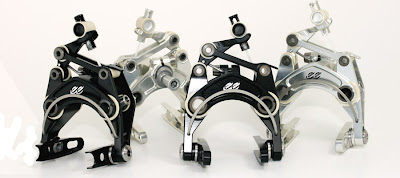They are having lots of fun with their branded bike, at
BikeNüt, and I’ve heard that some in the shop are beginning to call it the
Umlaut.
What makes this bike exciting is that with each new owner
comes the promise of a new project, something entirely unique. The assembled
bike is the result of long discussions with a client, of discovering habits,
preferences, requirements, and wishes. This is the way industrial production
should be: some parts come from far-away places, others from national or local
manufacturers, but the final product is assembled here, to respond to
individual wishes and needs.
In this particular bike, everything is pretty much
straightforward, from the gruppo, SRAM Red, to the wheels, Ambrosio rims. Apart
from the white saddle and bar tape (BTW, I’ve never seen any dirty fingerprints
on white tape, have you?), the future owner decided to go for EEBrakes, a very
innovative set that are the latest thing in stopping power: they are solid!
It is worth looking at these brakes in some detail. When we
apply a gradual pressure on most of the brakes commonly available, the friction
between the rim and the brake pads flexes these arms and reduces their
efficiency. Many manufacturers, such as Shimano and SRAM, strengthen the caliper
but, in doing so, increase their weight.
 |
| The EEBrakes. © EECycleworks |
EE Cycleworks, the maker of the EEBrakes, have taken a
different approach. They have reexamined the way brake works and have
engineered their brakes to overcome traditionally weaknesses. Rather than a
single point, they utilize multiple pivots to activate the caliper arms. The pivots
multiply the leverage in the caliper arms and reduce the amount of pressure
that is needed on the brake pads. The designers have increased the caliper width
but have eliminated every superfluous ounce of the main materials employed in
their construction, high-grade aluminum and titanium. As a result, the EEBrakes
are exceedingly smooth to operate, they have great modulation, and are light,
about 195 grams for a set.
These brakes look complex and different from the rest.
Admittedly, they take a little time to get used to them. Yet their performance
sets a new standard, one I would like to adopt as soon as I can afford it.

























